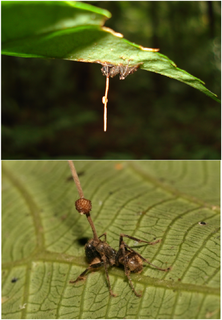 W
WAcanthocephala is a phylum of parasitic worms known as acanthocephalans, thorny-headed worms, or spiny-headed worms, characterized by the presence of an eversible proboscis, armed with spines, which it uses to pierce and hold the gut wall of its host. Acanthocephalans have complex life cycles, involving at least two hosts, which may include invertebrates, fish, amphibians, birds, and mammals. About 1420 species have been described.
 W
WApocephalus borealis is a species of North American parasitoid phorid fly that attacks bumblebees, honey bees, and paper wasps. This parasitoid's genus Apocephalus is best known for the "decapitating flies" that attack a variety of ant species, though A. borealis attacks and alters the behavior of bees and wasps. These flies are colloquially known as zombie flies and the bees they infect are colloquially known as zombees. Association with honey bees has so far only been documented from California, South Dakota, Oregon, Washington, British Columbia, and Vermont.
 W
WBaculoviridae is a family of viruses. Arthropods, lepidoptera, hymenoptera, diptera, and decapoda serve as natural hosts. There are currently 84 species in this family, divided among four genera.
 W
WThe emerald cockroach wasp or jewel wasp is a solitary wasp of the family Ampulicidae. It is known for its unusual reproductive behavior, which involves stinging a cockroach and using it as a host for its larvae. It thus belongs to the entomophagous parasites.
 W
WMermithidae is a family of nematode worms that are endoparasites in arthropods. As early as 1877, Mermithidae was listed as one of nine subdivisions of the Nematoidea. Mermithidae are confused with the horsehair worms of the phylum Nematomorpha that have a similar life history and appearance.
 W
WOphiocordyceps unilateralis is an insect-pathogenic fungus, discovered by the British naturalist Alfred Russel Wallace in 1859, and currently found predominantly in tropical forest ecosystems. O. unilateralis infects ants of the tribe Camponotini, with the full pathogenesis being characterized by alteration of the behavioral patterns of the infected ant. Infected hosts leave their canopy nests and foraging trails for the forest floor, an area with a temperature and humidity suitable for fungal growth; they then use their mandibles to attach themselves to a major vein on the underside of a leaf, where the host remains after its eventual death. The process leading to mortality takes 4–10 days, and includes a reproductive stage where fruiting bodies grow from the ant's head, rupturing to release the fungus's spores. O. unilateralis is, in turn, also susceptible to fungal infection itself, an occurrence that can limit its impact on ant populations, which has otherwise been known to devastate ant colonies.
 W
WThe Phoridae are a family of small, hump-backed flies resembling fruit flies. Phorid flies can often be identified by their escape habit of running rapidly across a surface rather than taking to the wing. This behaviour is a source of one of their alternate names, scuttle fly. Another vernacular name, coffin fly, refers to Conicera tibialis. About 4,000 species are known in 230 genera. The most well-known species is cosmopolitan Megaselia scalaris. At 0.4 mm in length, the world's smallest fly is the phorid Euryplatea nanaknihali.
 W
WSacculina is a genus of barnacles that is a parasitic castrator of crabs. They belong to a group called Rhizocephala. The adults bear no resemblance to the barnacles that cover ships and piers; they are recognised as barnacles because their larval forms are like other members of the barnacle class Cirripedia. The prevalence of this crustacean parasite in its crab host can be as high as 50%.
 W
WSacculina carcini, the crab hacker barnacle, is a species of parasitic barnacle in the family Sacculinidae, in particular a parasitic castrator, of crabs. The crab that most often is used as a host is the green crab, the natural range of which is the coasts of Western Europe and North Africa. It can be found attached to the crab's abdomen and affect consumption rates by humans.
 W
WToxoplasmosis is a parasitic disease caused by Toxoplasma gondii. Infections with toxoplasmosis usually cause no obvious symptoms in adults. Occasionally, people may have a few weeks or months of mild, flu-like illness such as muscle aches and tender lymph nodes. In a small number of people, eye problems may develop. In those with a weak immune system, severe symptoms such as seizures and poor coordination may occur. If infected during pregnancy, a condition known as congenital toxoplasmosis may affect the child.